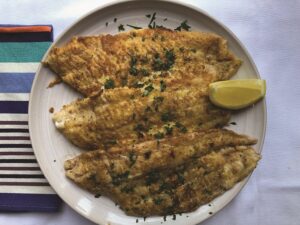On the Outer Cape, we are blessed with many kinds of fish that are hard to find really fresh elsewhere, such as bluefish and striped bass. But my favorite is the humble flounder, pan fried.
My wife and I serve flounder dorée — golden brown, that is — as an elegant dish for guests when we don’t have a lot of time to prepare. We also make it just for ourselves as an easy workday dinner.
Flounder is one of several flat fishes that are almost interchangeable with each other, but not quite. The most expensive is Dover sole, which is imported, though not just from Dover, the port that used to supply more of it to the world than any other. True European sole is also trawled in the North Sea and the Bay of Biscay. Bostonians sometimes call flounder “lemon sole.” But if you see that on a local restaurant menu, or sole, even, unless it specifies “Dover” it is almost surely flounder.

Flounder is one of those fish, like bluefish, that needs to be eaten really fresh. Otherwise, it starts tasting fishy, and the flesh loses its firmness and gets watery. Salmon can kick around in the fish market for a couple of days with no ill effects. Not flounder.
Just as important as when the flounder came in is when it was cut into filets. Ideally, you want flounder that was cut from the frame within a few hours of when you buy it. Even better if, as sometimes happens at Hatch’s in Wellfleet (which is closing for the season this weekend), you can watch them cut it.
It’s not impolite to ask when the flounder came in and when it was cut. If it’s not fresh, you could end up with soggy fish no matter how perfect your frying technique.
The ideal size for a piece of pan-fried flounder is about a third of a pound. Any smaller than that is too skinny to fry well. That’s the trouble with dabs, which typically run about a quarter pound or less per fillet. Larger filets are good, too, but you will need to cut them in half to serve them, which is less aesthetically pleasing than giving each diner a whole piece. I like fluke, also known as summer flounder.
Anyway, the key is size: get filets that weigh about a third of a pound each. There’s zero waste on a flounder fillet, and nobody except a fishmonger thinks half a pound per person is the right size for a portion for fish.
To prepare flounder dorée, make sure each fillet is absolutely dry to start. Season the filets with salt and pepper and then dredge them in Wondra flour, using either waxed paper or a large plate and making sure to shake off all excess. Wondra flour is low in protein, so when you fry with it less moisture is retained, which keeps the coating crisp. You’ll dip the filets in beaten eggs just before they hit your skillet, sizzling them in a mixture of olive oil and butter.
Use the largest frying pan you have so you can get the frying done in one round. If you only have a small pan, fry one round, removing the browned fish to a warm platter, then wipe out the fat and start fresh for the second round. A heavy steel-clad pan is ideal, as the butter burns easily in a dark pan.
The fish doesn’t take long to cook, just a minute or two on each side. Lemon and capers, after you plate the filets, are optional. The fish is so good that you don’t really need them.
Flounder Dorée
4 servings
4 flounder filets (about 6 oz. each)
Salt and pepper
1 cup Wondra flour
2 eggs
2 Tbsp. olive oil
2 Tbsp. butter
Capers, lemon, and parsley
- Pat the fish dry and season it well with salt and pepper. Beat the eggs in a shallow bowl. Put the flour on a plate or piece of parchment paper.
- Heat the olive oil and butter in your frying pan over medium-high heat. Let the pan get hotter than you think you should, so that it is bubbling; the fat is ready when it stops bubbling; that’s when the water in it has evaporated.
- Dip each piece of fish in the egg so that it is totally covered on both sides. Dredge it in the Wondra and shake off excess flour. Drop it into the pan. It will splash, so you will want to wear an apron. Shake the pan so that the filets brown evenly and don’t stick.
- The fish will cook very quickly. By the time it is dorée (golden) on the edges, after maybe 60 to 90 seconds, it is ready to turn. (You can use a spatula to peek at the bottom to confirm that the filets are golden brown.)
- Turn the fish over, then turn the heat down slightly and let it cook for another 90 seconds, or two minutes if it’s thick. Touch the fish — it’s done when the flesh is firm and springy.
- If using capers, swirl them in the butter left in the pan and pour over fish. Add a squeeze of lemon and a little minced parsley.
